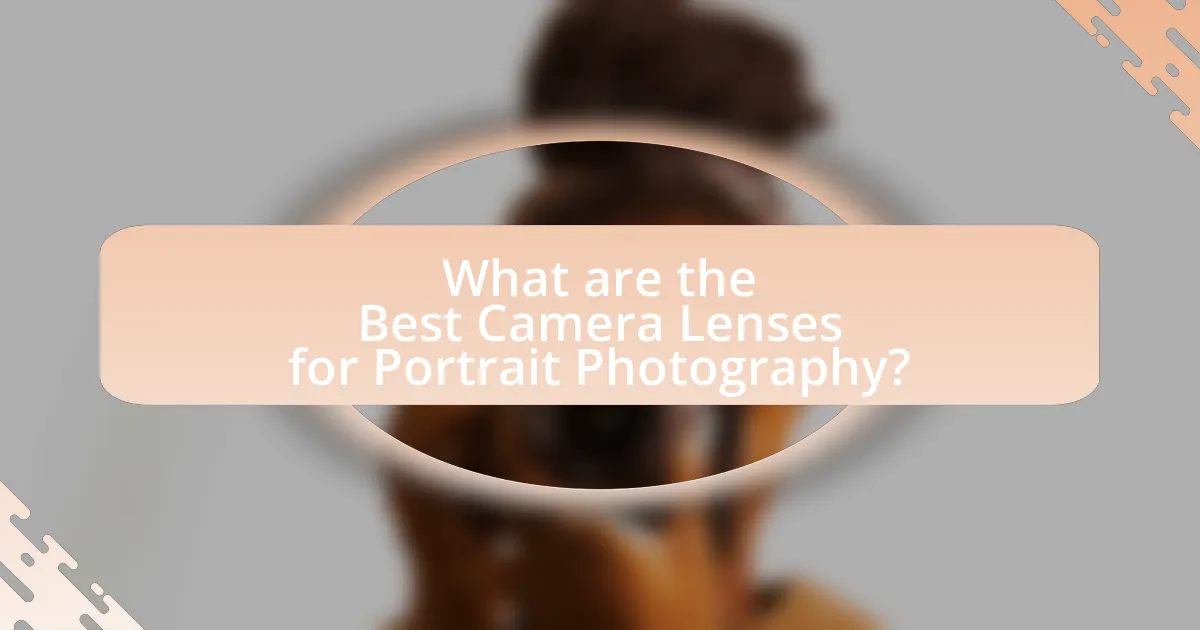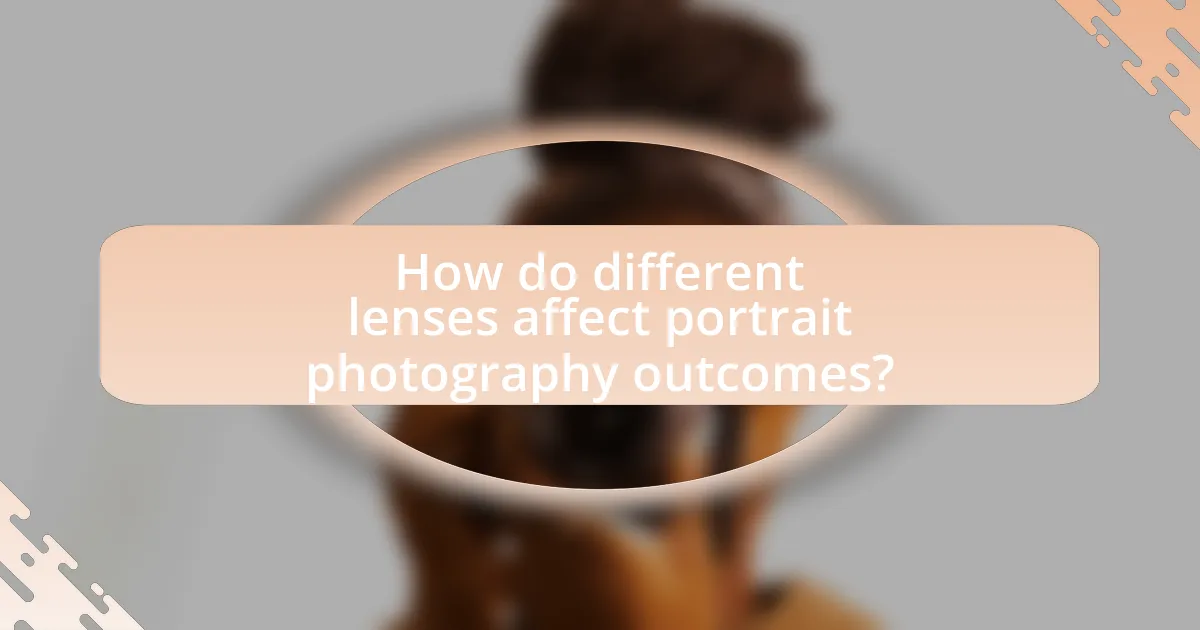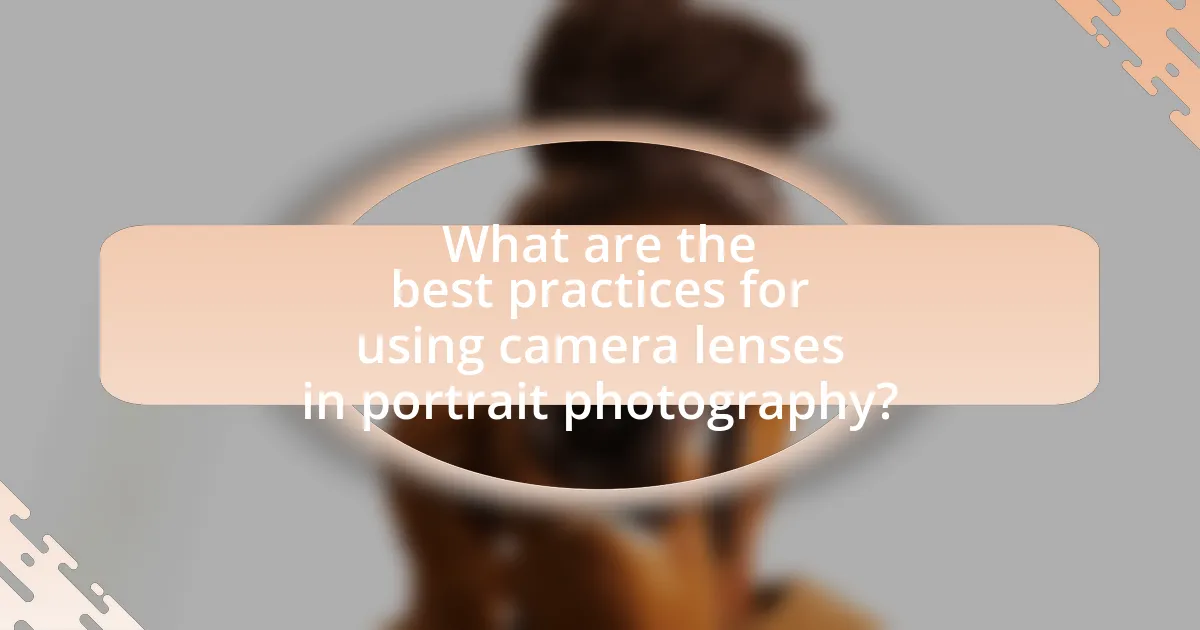The article focuses on the best camera lenses for portrait photography, emphasizing prime lenses with focal lengths between 85mm and 135mm, such as the Canon EF 85mm f/1.2L II and Nikon AF-S 85mm f/1.4G. It discusses the importance of lens choice in achieving flattering perspectives, subject isolation, and high image quality through wide apertures that create a shallow depth of field. Additionally, the article examines the impact of lens quality, aperture settings, and focal lengths on composition and clarity, while also addressing common mistakes to avoid and best practices for selecting the right lens for portrait work.

What are the Best Camera Lenses for Portrait Photography?
The best camera lenses for portrait photography are typically prime lenses with a focal length of 85mm to 135mm, such as the Canon EF 85mm f/1.2L II or the Nikon AF-S 85mm f/1.4G. These lenses provide a flattering perspective and excellent subject isolation due to their wide apertures, allowing for a shallow depth of field that beautifully blurs the background. Additionally, lenses like the 50mm f/1.8 and 70-200mm f/2.8 are also popular choices, offering versatility and sharpness. The effectiveness of these lenses is supported by their ability to produce high-quality images with smooth bokeh, making them ideal for capturing the details and expressions in portrait photography.
Why is lens choice crucial for portrait photography?
Lens choice is crucial for portrait photography because it directly influences the composition, depth of field, and overall aesthetic of the image. A lens with a longer focal length, such as an 85mm or 135mm, allows for flattering compression of facial features and creates a pleasing background blur, known as bokeh, which isolates the subject. This effect enhances the subject’s prominence in the frame, making the portrait more engaging. Additionally, using a lens with a wide aperture, like f/1.8 or f/2.8, enables photographers to achieve a shallow depth of field, further emphasizing the subject while softening distracting elements in the background. These characteristics are essential for capturing the essence of the subject and conveying emotion effectively in portrait photography.
How does lens quality impact image sharpness and clarity?
Lens quality directly impacts image sharpness and clarity by determining how well the lens can focus light onto the camera sensor. High-quality lenses are designed with superior glass materials and advanced optical coatings that minimize distortions, aberrations, and flare, resulting in sharper images with greater detail. For instance, a study published in the Journal of Optical Society of America found that lenses with better optical design and higher-quality glass can reduce chromatic aberration, leading to clearer images. Additionally, lenses with larger apertures allow more light to enter, enhancing clarity in low-light conditions, which is crucial for portrait photography.
What role does lens aperture play in portrait photography?
Lens aperture plays a crucial role in portrait photography by controlling the amount of light entering the camera and influencing depth of field. A wider aperture, such as f/1.8 or f/2.8, allows more light, enabling faster shutter speeds and creating a shallow depth of field that beautifully blurs the background, isolating the subject. This effect enhances the subject’s prominence and adds a professional quality to portraits. Conversely, a narrower aperture, like f/8 or f/11, reduces light intake and increases depth of field, which can be useful for group portraits but may detract from the subject’s focus. The choice of aperture directly impacts the aesthetic quality of the portrait, making it a fundamental consideration for photographers.
What types of lenses are commonly used for portrait photography?
Commonly used lenses for portrait photography include prime lenses, particularly 50mm and 85mm focal lengths, and zoom lenses like 24-70mm. Prime lenses are favored for their wide apertures, allowing for shallow depth of field and excellent subject isolation, which enhances the portrait’s aesthetic. The 85mm lens is especially popular for its flattering compression and perspective, making it ideal for headshots. Zoom lenses, such as the 24-70mm, offer versatility in framing and composition while maintaining good image quality, making them suitable for various portrait styles.
What are prime lenses and why are they favored for portraits?
Prime lenses are fixed focal length lenses that do not zoom, typically offering superior optical quality and wider maximum apertures compared to zoom lenses. They are favored for portraits because their wide apertures, often ranging from f/1.2 to f/2.8, allow for excellent subject isolation through shallow depth of field, creating a pleasing bokeh effect that enhances the subject’s features while softening the background. Additionally, prime lenses generally provide sharper images and better low-light performance, making them ideal for capturing detailed and vibrant portraits.
How do zoom lenses compare to prime lenses for portrait work?
Zoom lenses offer versatility in focal lengths, making them convenient for portrait work, while prime lenses typically provide superior image quality and wider apertures. The flexibility of zoom lenses allows photographers to quickly adjust framing without changing lenses, which is beneficial in dynamic shooting environments. In contrast, prime lenses often excel in producing sharper images with better low-light performance due to their larger maximum apertures, such as f/1.8 or f/1.4, which can create a more pronounced bokeh effect. Studies indicate that prime lenses generally yield higher resolution and contrast, enhancing the overall quality of portrait images.
What specifications should you consider when selecting a lens for portraits?
When selecting a lens for portraits, consider specifications such as focal length, aperture, and optical quality. Focal length between 85mm and 135mm is ideal for flattering facial proportions, while a wide aperture (f/1.8 or wider) allows for shallow depth of field, creating a pleasing background blur. Additionally, high optical quality ensures sharpness and color accuracy, which are crucial for capturing fine details in portraits. These specifications are supported by industry standards, as lenses within this range are commonly recommended by professional photographers for portrait work.
How does focal length affect the composition of portrait images?
Focal length significantly influences the composition of portrait images by altering perspective and subject framing. Longer focal lengths, such as 85mm to 135mm, compress the background and create a pleasing bokeh effect, which isolates the subject and enhances facial features. In contrast, shorter focal lengths, like 35mm or 50mm, can introduce distortion, particularly at close distances, making facial features appear exaggerated. This effect is supported by the fact that lenses with longer focal lengths reduce the depth of field, allowing for a more focused subject against a blurred background, which is often desirable in portrait photography.
What is the significance of lens stabilization in portrait photography?
Lens stabilization is significant in portrait photography as it reduces camera shake, allowing for sharper images, especially in low-light conditions or at slower shutter speeds. This stabilization is crucial because portraits often require precise focus on the subject’s eyes, and any movement can lead to blurriness. Studies show that lens stabilization can improve image sharpness by up to 4 stops, enabling photographers to capture clear, detailed portraits without increasing ISO, which can introduce noise.

How do different lenses affect portrait photography outcomes?
Different lenses significantly affect portrait photography outcomes by altering perspective, depth of field, and compression. For instance, a prime lens with a wide aperture, such as an 85mm f/1.8, creates a shallow depth of field, allowing the subject to stand out against a blurred background, which enhances focus on facial features. In contrast, a wide-angle lens, like a 24mm, can distort facial proportions, making features appear exaggerated, which is generally less flattering for portraits. Additionally, longer focal lengths, such as 135mm, compress the background, creating a more aesthetically pleasing separation between the subject and the backdrop. This effect is supported by the principle of focal length in photography, where longer lenses provide a more flattering perspective for portraits.
What are the advantages of using a 50mm lens for portraits?
The advantages of using a 50mm lens for portraits include its ability to produce sharp images with minimal distortion and a natural perspective that closely resembles human vision. This focal length allows photographers to achieve a pleasing depth of field, effectively isolating the subject from the background while maintaining enough context in the frame. Additionally, the 50mm lens typically has a wide maximum aperture, such as f/1.8 or f/1.4, which enables excellent low-light performance and beautiful bokeh, enhancing the aesthetic quality of portrait images. These characteristics make the 50mm lens a versatile and popular choice among portrait photographers.
Why is the 85mm lens considered a classic choice for portraiture?
The 85mm lens is considered a classic choice for portraiture due to its ideal focal length that provides flattering perspective and compression for facial features. This lens allows photographers to maintain a comfortable distance from their subjects while achieving a natural look, minimizing distortion that can occur with wider lenses. Additionally, the 85mm lens typically offers a wide maximum aperture, such as f/1.8 or f/1.4, which enables beautiful background blur (bokeh) that isolates the subject and enhances the overall aesthetic of the portrait. This combination of focal length and aperture makes the 85mm lens a preferred tool among portrait photographers for capturing sharp, detailed images with pleasing depth of field.
What unique benefits does a 135mm lens provide for portrait photography?
A 135mm lens offers unique benefits for portrait photography, primarily through its ability to create flattering compression and a shallow depth of field. This focal length allows photographers to maintain a comfortable distance from the subject while still achieving a tight frame, which enhances facial features and minimizes distortion. Additionally, the shallow depth of field produced by a 135mm lens effectively isolates the subject from the background, resulting in a pleasing bokeh that emphasizes the subject and adds a professional quality to the image. These characteristics make the 135mm lens particularly well-suited for capturing intimate and striking portraits.
How do wide-angle lenses influence portrait photography?
Wide-angle lenses influence portrait photography by allowing photographers to capture a broader scene while creating a sense of depth and perspective. This lens type can exaggerate facial features, making them appear larger and more prominent, which can be both a creative choice and a potential drawback depending on the desired outcome. For instance, when photographing a subject close to the lens, the nose may appear larger compared to the rest of the face, which can lead to unflattering results if not managed carefully. Additionally, wide-angle lenses enable the inclusion of more background context, enhancing storytelling within the portrait. This effect is particularly useful in environmental portraits where the setting plays a significant role in the narrative.
What are the creative uses of wide-angle lenses in portraiture?
Wide-angle lenses in portraiture creatively emphasize the subject while incorporating more of the environment, enhancing storytelling. This technique allows photographers to create dynamic compositions by exaggerating perspective, making the subject appear larger against a more expansive background. For instance, placing the subject close to the lens can produce a dramatic effect, highlighting facial features while simultaneously capturing contextual elements that add depth to the narrative. Additionally, wide-angle lenses can be used to create unique angles and viewpoints, offering a fresh perspective that traditional portrait lenses may not achieve. This versatility is particularly effective in environmental portraits, where the setting plays a crucial role in the story being told.
What challenges do wide-angle lenses present in portrait photography?
Wide-angle lenses present significant challenges in portrait photography, primarily due to distortion and perspective issues. When used for portraits, these lenses can exaggerate facial features, making noses appear larger and faces wider, which detracts from the subject’s natural appearance. Additionally, the increased depth of field associated with wide-angle lenses can lead to backgrounds being more prominent, potentially distracting from the subject. This distortion effect is particularly pronounced when the subject is positioned close to the lens, as the perspective can create unflattering proportions.

What are the best practices for using camera lenses in portrait photography?
The best practices for using camera lenses in portrait photography include selecting a lens with a focal length between 85mm and 135mm, as this range provides flattering perspectives and minimizes distortion. Using a wide aperture, such as f/1.8 or f/2.8, allows for a shallow depth of field, which effectively isolates the subject from the background, creating a pleasing bokeh effect. Additionally, maintaining a distance of at least six feet from the subject helps to avoid distortion of facial features. Employing prime lenses, known for their sharpness and image quality, enhances the overall clarity of portraits. These practices are supported by the fact that many professional portrait photographers favor these specifications to achieve high-quality results.
How can you maximize the potential of your lens for portraits?
To maximize the potential of your lens for portraits, use a lens with a wide aperture, such as f/1.8 or f/2.8, to achieve a shallow depth of field that beautifully blurs the background while keeping the subject in sharp focus. This technique enhances the subject’s prominence and creates a pleasing bokeh effect, which is essential in portrait photography. Additionally, utilizing a longer focal length, typically between 85mm and 135mm, allows for flattering compression of facial features and reduces distortion, resulting in more appealing portraits. Studies in photography emphasize that lenses with these specifications are preferred by professionals for their ability to create visually striking images.
What techniques can enhance the bokeh effect in portrait images?
To enhance the bokeh effect in portrait images, photographers can utilize wide aperture settings, typically f/1.8 or wider, which create a shallow depth of field that blurs the background. Additionally, using longer focal lengths, such as 85mm or 135mm, can further isolate the subject and enhance the bokeh quality. Incorporating distance between the subject and the background also contributes to a more pronounced bokeh effect, as it increases the blur. Furthermore, selecting lenses with rounded aperture blades can produce smoother and more aesthetically pleasing bokeh. These techniques are supported by the fact that lenses designed for portrait photography often emphasize these characteristics, making them ideal for achieving a desirable bokeh effect.
How does lighting interact with different lenses in portrait photography?
Lighting interacts with different lenses in portrait photography by influencing the way light is captured and rendered, affecting exposure, contrast, and depth of field. For instance, a wide aperture lens, such as an f/1.8, allows more light to enter, creating a shallow depth of field that beautifully blurs the background while highlighting the subject, which is ideal for portraits. Conversely, a lens with a smaller aperture, like f/8, captures less light, resulting in greater depth of field and more detail in both the subject and background, which can alter the portrait’s overall impact. Additionally, the focal length of the lens affects how light falls on the subject; longer focal lengths compress the background and create a more flattering perspective, while shorter focal lengths can introduce distortion. This interaction between lighting and lens characteristics is crucial for achieving the desired aesthetic in portrait photography.
What common mistakes should be avoided when choosing a lens for portraits?
When choosing a lens for portraits, common mistakes to avoid include selecting a lens with an inappropriate focal length, such as using a wide-angle lens that can distort facial features. Portrait photography typically benefits from lenses in the 85mm to 135mm range, which provide flattering compression and depth of field. Another mistake is neglecting the aperture; a lens with a wide maximum aperture (like f/1.8 or f/2.8) allows for better subject isolation and bokeh, enhancing the portrait’s aesthetic. Additionally, failing to consider the lens’s quality can lead to images that lack sharpness and detail; investing in a reputable brand or model known for its optical performance is crucial. Lastly, overlooking the importance of stabilization can result in blurry images, especially in low-light conditions, making it essential to choose a lens with image stabilization features if needed.
How can improper focal length affect portrait composition?
Improper focal length can distort facial features and alter the perceived proportions in portrait composition. For instance, using a wide-angle lens can exaggerate the size of the subject’s nose and forehead, while compressing the background, leading to an unflattering representation. Conversely, a telephoto lens can create a more flattering perspective by compressing facial features and providing a pleasing background blur, but if the focal length is too long, it may result in a narrow field of view, cutting off important elements of the composition. Studies in photography emphasize that the ideal focal length for portraits typically ranges from 85mm to 135mm, as this range minimizes distortion and enhances the subject’s natural appearance.
What are the pitfalls of using the wrong aperture settings in portraits?
Using the wrong aperture settings in portraits can lead to undesirable outcomes such as improper focus, loss of detail, and unflattering backgrounds. When the aperture is set too wide, the subject may be out of focus, resulting in a shallow depth of field that can blur important facial features. Conversely, if the aperture is too narrow, the background may become overly sharp and distracting, drawing attention away from the subject. Additionally, incorrect aperture settings can affect exposure, leading to images that are either too bright or too dark, which diminishes the overall quality of the portrait. These pitfalls highlight the importance of selecting the appropriate aperture to achieve the desired artistic effect and maintain clarity in portrait photography.
What tips can help you select the right lens for your portrait photography needs?
To select the right lens for portrait photography, prioritize a lens with a focal length between 85mm and 135mm, as this range provides flattering perspectives and minimizes distortion. Lenses in this range, such as an 85mm f/1.8 or a 135mm f/2, allow for a comfortable working distance while achieving beautiful background blur, known as bokeh, which enhances the subject’s prominence. Additionally, consider lenses with wide apertures (f/1.4 or f/1.8) to create a shallow depth of field, isolating the subject from the background. This technique is supported by the fact that wide apertures allow more light, making it easier to shoot in various lighting conditions while achieving a professional look.